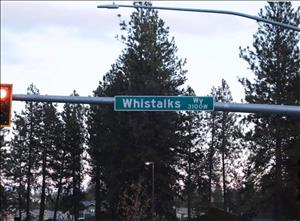On December 14, 2020, during its regular weekly meeting, the Spokane City Council unanimously votes to change the name of Fort George Wright Drive in west Spokane to Whistalks Way. Colonel George Wright (1803-1865), a notorious Indian fighter, led U.S. Army troops through the region in September 1858 in a scorched-earth campaign of revenge. That campaign resulted in the deaths of people from several tribes -- some 17 by hanging, many more by gunfire. He also ordered his troops to burn caches of Indian food and to shoot hundreds of their horses. One of the few Indians to escape his grasp was the Spokane woman warrior Whist-alks (1838-1909). Her name supplants Wright's as part of a reckoning led by the Spokane Tribe of Indians.
George Wright
An 1822 graduate of West Point, Colonel George Wright was sent to Washington Territory to fight in the Yakama Indian War of 1855-1856. He returned in 1858, after Spokane, Yakama, Palouse, and Coeur d'Alene tribal members joined forces to defeat troops led by Lieutenant Colonel Edward Steptoe (1816-1865) and captured some of their weapons.
Wright's troops overwhelmed tribal forces in two battles near present-day Spokane -- Four Lakes on September 1, 1858, and Spokane Plains four days later. Continuing east, on September 8 Wright ordered his troops to slaughter 800 Indian horses along the Spokane River on a plain near present-day Liberty Lake, a site later named Horse Slaughter Camp. Wright's purpose in shooting the horses was both to disable the running battles waged by Indians and to undermine morale. Clubbing and shooting the horses took two days, and observers reported that the river ran red with blood from dead and wounded horses, and the Spokane Valley plains rang with the cries of the dying and distressed horses. Wright also burned the barns of grain that local Indians stored for winter food.
After signing agreements with the Coeur d'Alene Tribe, Wright captured Chief Owhi of the Yakama. He then summoned Owhi's son Qualchan, whom he regarded as an architect of the Yakama War, to his camp near the bank of the Ned-Whauld River (later called both Hangman Creek and Latah Creek). Historians disagree as to why Qualchan so willingly rode into Wright's camp on September 25, but military records confirm that he was promptly seized and hanged within 15 minutes. Owhi was kept captive and later killed, but Qualchan's wife Whist-alks, a member of the Spokane Tribe, and his half-brother Lokout (1834-1913), who had both accompanied Qualchan, escaped. They outlived Wright by many decades; the army officer drowned in a shipwreck off the California coast in 1865.
An army post established in west Spokane in the 1890s was named Fort George Wright in Wright's honor, and the city named a major thoroughfare near the post Fort George Wright Drive. Both a different Spokane street and a footrace took Qualchan's name.
Whist-alks
Whist-alks and Lokout rode away from Wright's camp and lived out the remaining half-century of their lives as domestic partners.
Whist-alks is commemorated in her Spokane Indian Tribe's historical records and traditions as a warrior woman, one who took part in the Columbia Plateau wars both before and after her first husband was executed. In visual art, and as part of the tribe's conventional wisdom, she is seen defiantly hurling a lance into the ground and wheeling her horse to leave Wright's camp, once she saw her husband seized or hanged. According both to tribal tradition and a consensus of non-Native historians, Wright committed an act of treachery because Qualchan and his party had entered Wright's camp bearing the white flag of truce.
Following that treachery, Whist-alks and Lokout continued to combat white occupation of their people's lands. Lokout, before and after his brother's execution, was a guerilla fighter and a sniper. Wounded and unconscious on one battlefield, he suffered a near-mortal forehead blow from a military volunteer's gun-butt swung to kill him. Photographer Edward Curtis hid that brow gouge in a comb-over and immortalized him in a regal portrait. Whist-alks and Lokout lived the last decades of their lives at the confluence of the Spokane and Columbia rivers.
A New Street Name
The roadway that used to bear Wright's name runs on the west side of Spokane for a mile and a half. It was officially renamed late in 2020, through consultation within the Spokane Tribe of Indians and by the unanimous vote of the seven-member Spokane City Council on December 14. The Native American Alliance for Policy and Action, speaking for the 16,000 or so Native Americans from various tribes who live in Spokane, also supported the name change. A community celebration was held in August 2021 at Spokane Falls Community College, located on the renamed street, to honor the name change.
Margo Hill, a lawyer and an associate professor of urban and tribal planning at Eastern Washington University and a spokesperson for the Spokane Tribe, was a leader of the effort to change the name. An enrolled member of the Tribe, Hill grew up along the Spokane River, where one of her grandmother's dishes was a fish soup in which the eyes of salmon swam.

